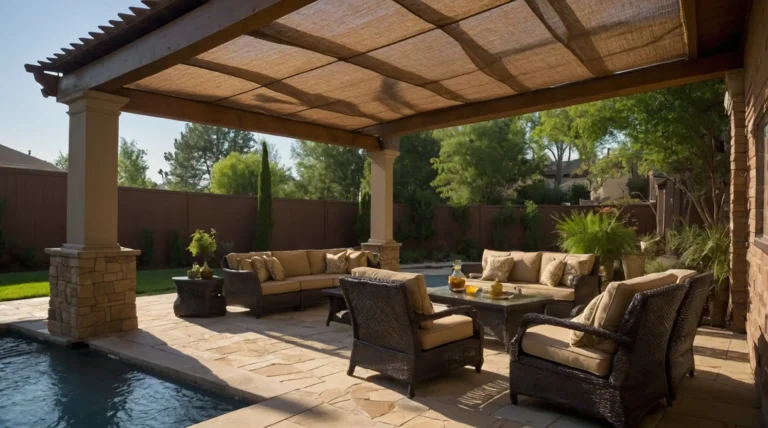27 Japandi Designed Yoga Studios Ideas
Japandi design merges Japanese minimalism with Scandinavian functionality to create serene, uncluttered spaces perfect for yoga practice.
This aesthetic emphasizes natural materials, clean lines, and mindful simplicity.
The philosophy celebrates imperfection while prioritizing quality and sustainability. You’ll discover how neutral palettes and organic textures enhance meditation and movement.
These thoughtful design elements foster deeper connections between mind, body, and environment.
Let these peaceful concepts transform your yoga studio into a tranquil sanctuary.
1: Natural Bamboo Flooring

Install sustainable bamboo flooring that provides warm, natural surfaces with excellent grip for yoga poses while maintaining the eco-friendly Japandi aesthetic.
The renewable material offers durability and comfort underfoot during practice sessions.
You’ll create grounding connection with natural elements while supporting environmental sustainability.
Choose matte finishes that prevent slipping and reduce glare during sessions.
The bamboo’s natural grain patterns add subtle texture without overwhelming visual simplicity.
2: Sliding Shoji Screen Dividers

Create flexible space division using traditional shoji screens with natural wood frames and translucent paper panels that filter light beautifully.
These movable partitions adapt studio layouts for different class sizes while maintaining visual continuity.
You’ll achieve privacy without blocking natural light flow throughout the space.
The screens add authentic Japanese elements while serving practical room division needs.
Choose high-quality wood frames that complement your overall color palette.
3: Minimalist Storage Cubbies

Design built-in storage cubbies using light wood that organize yoga props, mats, and personal belongings without visual clutter or complex hardware.
The clean-lined compartments maintain Japandi simplicity while providing essential storage functionality.
You’ll keep spaces organized while honoring the aesthetic’s uncluttered principles.
Include soft-close mechanisms and natural wood finishes for quiet operation.
The storage becomes part of the architectural design rather than added furniture.
4: Large Format Skylights
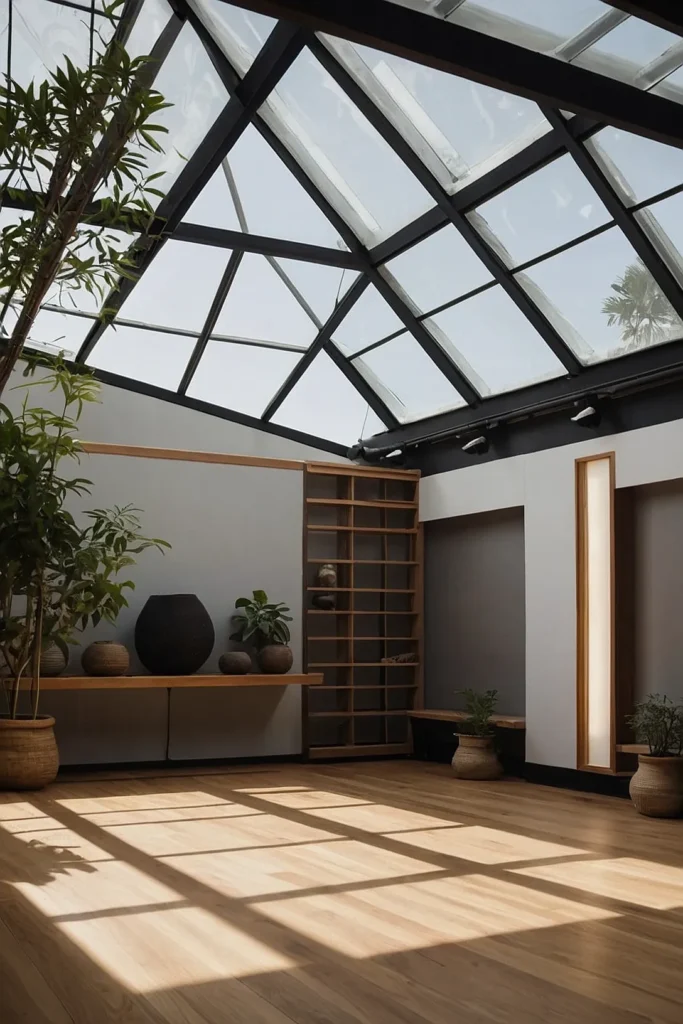
Install expansive skylights that flood your studio with natural light while creating connections to sky, clouds, and changing weather patterns.
The overhead illumination reduces dependence on artificial lighting while enhancing mood and energy levels.
You’ll practice under natural rhythms that support circadian wellness.
Include motorized shades for light control during different practices and seasons.
The skylights become focal points that draw attention upward naturally.
5: Living Moss Wall Features

Create accent walls using preserved moss that adds natural texture and air-purifying qualities without maintenance requirements of living plants.
The organic wall treatment softens hard surfaces while maintaining Japandi’s connection to nature.
You’ll introduce biophilic elements that promote calm and concentration.
Choose varieties with subtle color variations for visual interest without overwhelming simplicity.
The moss walls provide natural sound absorption benefits.
6: Tatami Mat Practice Areas

Designate special meditation or floor practice zones using traditional tatami mats that honor Japanese cultural elements while providing comfortable surfaces.
The woven rush mats offer firm support for seated poses while adding authentic cultural connection.
You’ll create dedicated spaces for specific practices within larger studios.
Maintain mats properly for longevity and hygiene in studio environments.
The traditional elements add depth and meaning to modern practice spaces.
7: Neutral Linen Wall Coverings

Apply natural linen wall coverings in soft, neutral tones that add texture and warmth while maintaining the calm, monochromatic Japandi palette.
The fabric surfaces soften acoustics while creating tactile interest without bold patterns or colors.
You’ll achieve sophisticated texture that supports peaceful environments.
Choose washable or easily maintained fabrics for studio hygiene requirements.
The natural fibers add organic elements that complement wood and stone materials.
8: Japanese Soaking Tub Corner

Install a traditional wooden soaking tub in recovery areas for post-practice relaxation and muscle recovery with authentic cultural elements.
The hinoki wood tubs provide therapeutic benefits while adding significant design impact.
You’ll offer unique amenities that distinguish your studio from conventional facilities.
Include proper drainage and ventilation for indoor installation safety. The tub becomes both functional amenity and artistic focal point.
9: Integrated Sound Bowl Niches

Design built-in wall niches specifically sized for singing bowls and sound healing instruments that maintain clean lines while providing functional storage.
The purposeful alcoves keep instruments accessible while preventing clutter on floors or surfaces.
You’ll integrate sound therapy tools seamlessly into architectural design.
Include soft lighting within niches to highlight beautiful instruments as decorative elements.
The integration shows respect for sound healing practices.
10: Natural Stone Water Features

Incorporate simple stone water features with gentle trickling sounds that promote relaxation while adding natural elements and humidity control.
The subtle water sounds mask outside noise while creating peaceful ambiance throughout practice sessions.
You’ll introduce calming natural sounds without complex audio systems.
Choose stones that complement your overall palette and require minimal maintenance.
The water features should enhance rather than dominate the space.
11: Floor-to-Ceiling Windows
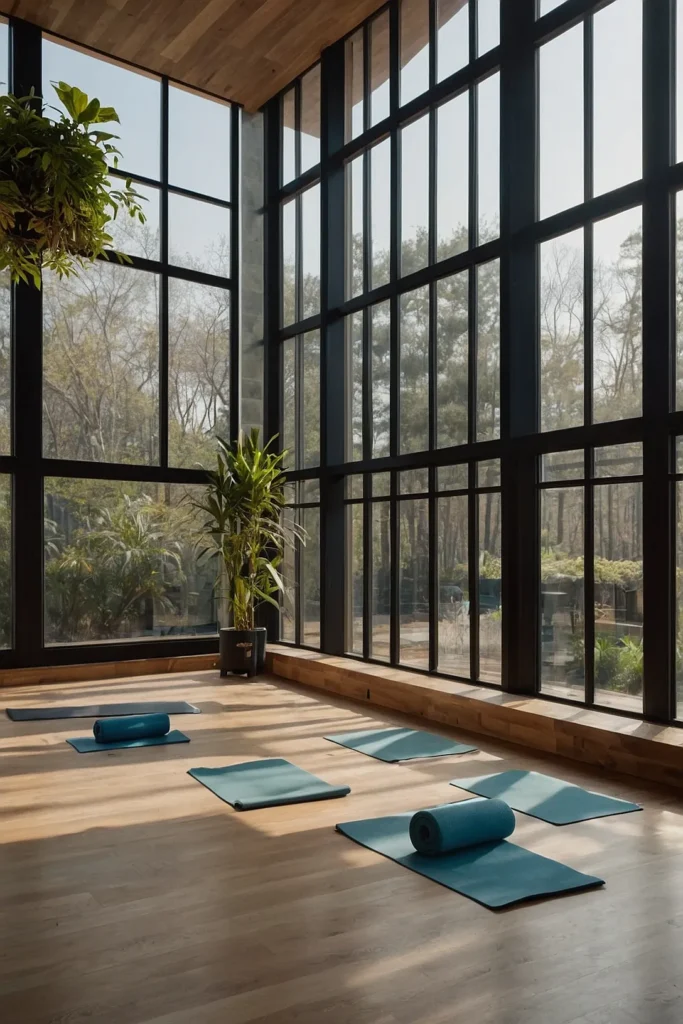
Install large windows with minimal frames that maximize natural light and outdoor views while maintaining clean, uninterrupted architectural lines.
The expansive glass creates visual connections with nature while flooding spaces with beneficial natural illumination.
You’ll blur boundaries between indoor and outdoor environments.
Include high-performance glass for energy efficiency and glare control. The windows become walls of light that transform throughout the day.
12: Suspended Aerial Yoga Points

Install ceiling-mounted anchor points using clean, minimal hardware that supports aerial yoga while maintaining the uncluttered aesthetic overhead.
The functional elements disappear into the ceiling design while providing versatile practice options.
You’ll expand class offerings without compromising visual simplicity.
Choose hardware that meets safety standards while maintaining architectural elegance. The anchor points should feel integrated rather than added afterward.
13: Warm Wood Accent Walls

Create focal walls using light oak or ash wood in vertical or horizontal patterns that add warmth without overwhelming the minimalist design.
The natural wood grain provides visual interest while maintaining neutral color schemes.
You’ll introduce organic patterns that support the Japandi connection to nature.
Choose sustainable wood sources and natural finishes for environmental alignment. The accent walls become subtle focal points that ground the space.
14: Meditation Cushion Alcoves

Design built-in seating alcoves with integrated storage for meditation cushions that provide comfortable spots while maintaining clean architectural lines.
The purposeful niches offer quiet retreat spaces within larger studios while keeping cushions organized and accessible.
You’ll create intimate meditation zones.
Include soft LED lighting and ergonomic proportions for extended sitting comfort. The alcoves become sanctuary spaces within sanctuary spaces.
15: Air Purifying Plant Displays

Arrange carefully selected air-purifying plants in simple, natural containers that improve air quality while adding life and subtle color variations.
The living elements enhance breathing quality while maintaining the natural aesthetic principles.
You’ll create healthier environments while honoring biophilic design values.
Choose low-maintenance varieties that thrive in studio lighting conditions.
The plants should complement rather than compete with architectural elements.
16: Handcrafted Ceramic Accents

Display beautiful, imperfect ceramic pieces that embody wabi-sabi principles while serving functional purposes like water vessels or decorative elements.
The artisanal objects celebrate craftsmanship and imperfection while adding personal touches to minimalist spaces.
You’ll honor traditional Japanese aesthetic values through careful curation.
Choose pieces that reflect natural earth tones and organic shapes. The ceramics become meditation objects that inspire contemplation and appreciation.
17: Natural Fiber Area Rugs

Place jute or hemp area rugs in relaxation zones that define spaces while adding natural textures and sound absorption properties.
The organic materials complement hard flooring while creating comfort zones for stretching and meditation.
You’ll soften acoustics while maintaining natural material consistency.
Choose rugs with simple patterns or solid colors that support the calm aesthetic. The natural fibers add warmth without visual complexity.
18: Hidden Climate Control
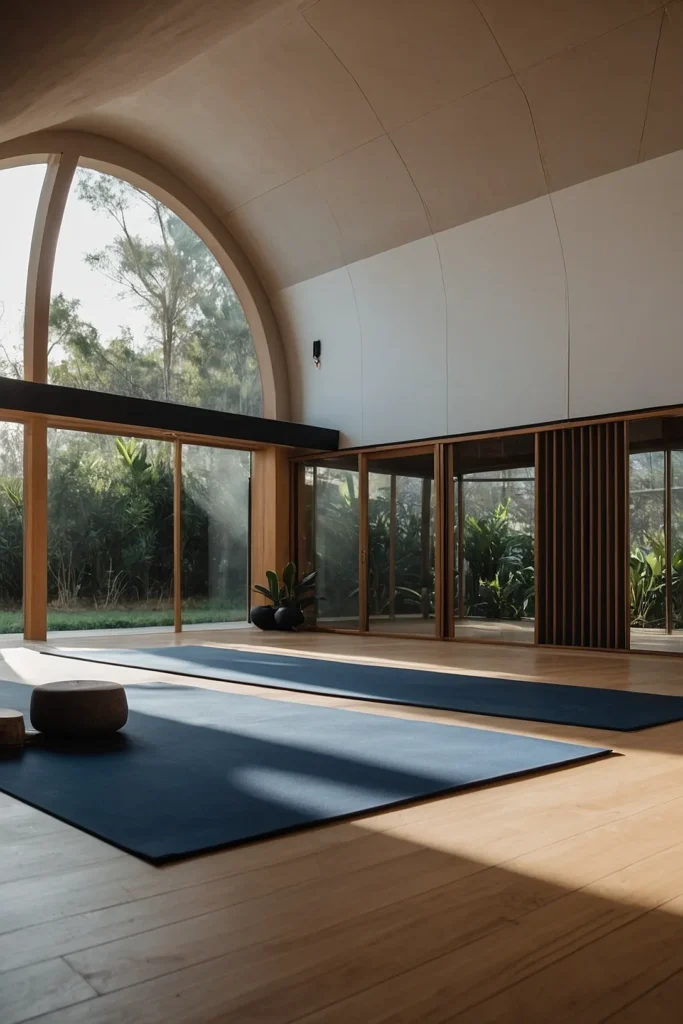
Install invisible climate systems that maintain optimal temperature and humidity without visible vents or equipment that disrupts clean design lines.
The concealed systems provide comfort while preserving architectural integrity and visual simplicity.
You’ll ensure practice comfort without compromising aesthetic values.
Include air purification and quiet operation for distraction-free practice environments.
The hidden systems demonstrate thoughtful planning and attention to detail.
19: Sunrise Color Temperature Lighting

Install LED systems that mimic natural daylight cycles from warm sunrise tones to cool midday light supporting circadian rhythms.
The dynamic lighting supports natural energy cycles while reducing dependence on harsh artificial illumination.
You’ll enhance practice quality through biologically appropriate lighting.
Include manual override controls for specific practice requirements and moods.
The lighting system becomes invisible technology that supports natural wellness.
20: Japanese Garden Views

Position studios to overlook carefully designed Japanese-inspired gardens with rocks, minimal plantings, and water elements that extend Japandi aesthetics outdoors.
The visual connection provides meditation focal points while extending interior design principles into landscape.
You’ll create seamless indoor-outdoor experiences.
Include seasonal elements that change naturally throughout the year. The garden views become living artwork that evolves with natural cycles.
21: Integrated Prop Storage Walls

Design entire walls as storage systems using clean, handle-free panels that organize yoga props while maintaining uninterrupted visual surfaces.
The invisible storage maintains clutter-free environments while keeping essential equipment accessible.
You’ll achieve maximum organization without visual complexity or obvious storage solutions.
Include soft-close mechanisms and organizational systems for different prop types.
The storage walls become architectural features that serve functional needs.
22: Mindful Material Transitions

Create thoughtful transitions between different flooring materials using natural thresholds that define spaces without abrupt changes or obvious dividers.
The subtle material changes guide movement and define zones while maintaining visual flow throughout the studio.
You’ll create wayfinding through material choices.
Choose complementary textures and colors that support the overall palette.
The transitions should feel natural and intentional rather than accidental.
23: Aromatherapy Integration Systems
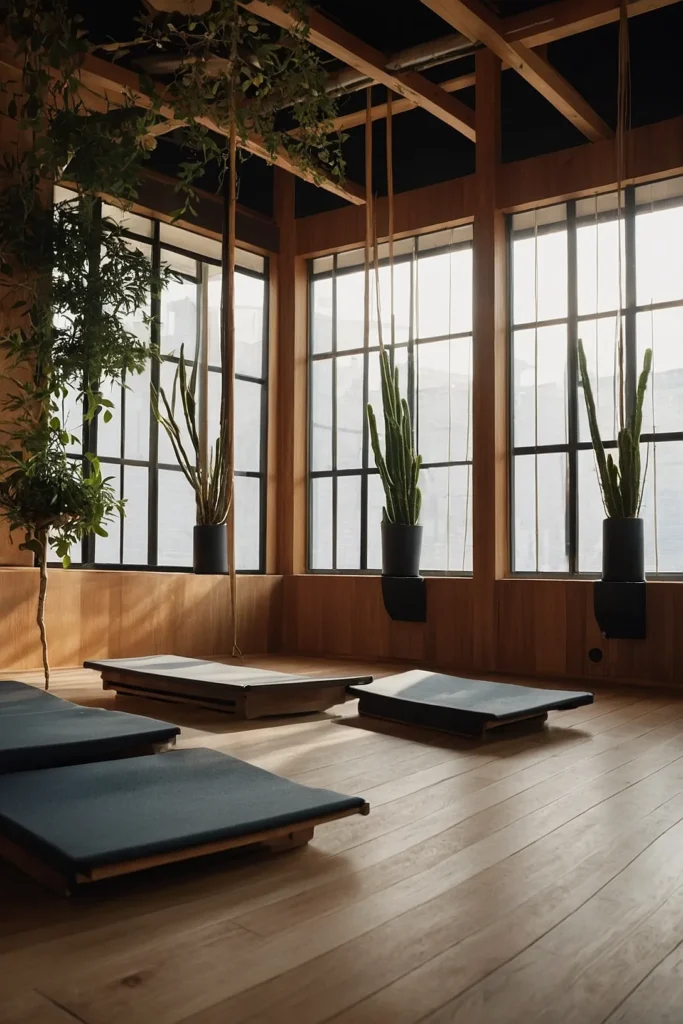
Install discrete essential oil diffusion systems that provide subtle, natural scents supporting different practices without overwhelming sensitive practitioners.
The integrated aromatherapy enhances mood and relaxation while maintaining the natural, chemical-free environment values.
You’ll engage additional senses through natural plant essences.
Include adjustable intensity controls and seasonal scent rotations.
The aromatherapy should complement rather than dominate the sensory experience.
24: Flexible Seating Elements
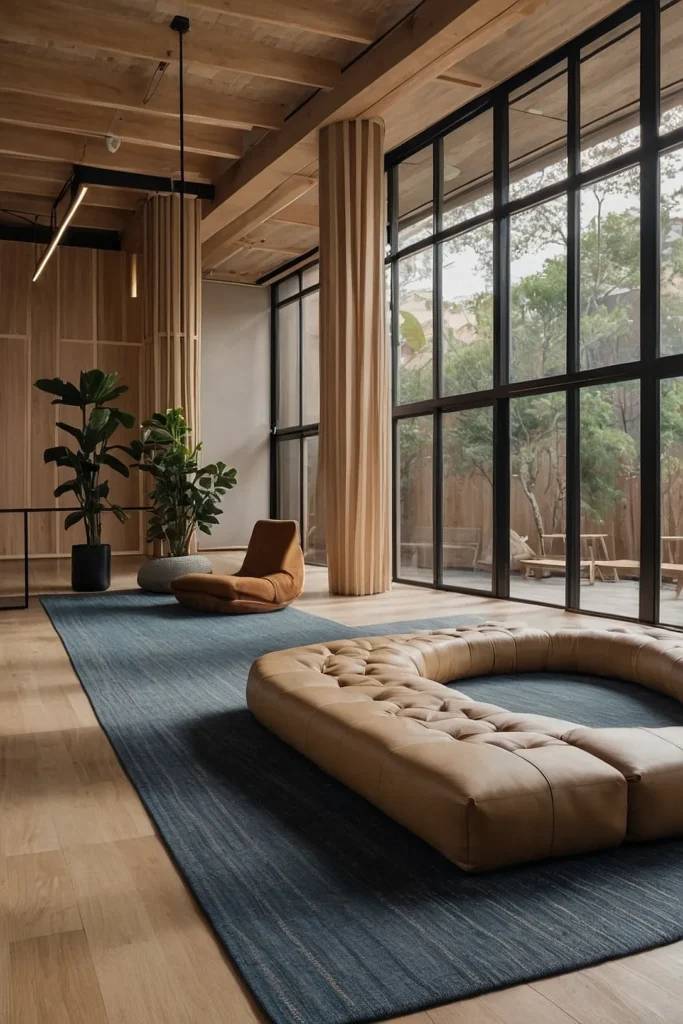
Provide various seating options using natural materials like wood stools, floor cushions, and built-in benches that accommodate different body types.
The diverse seating supports inclusive practice while maintaining design consistency through material choices.
You’ll welcome all practitioners while preserving aesthetic integrity.
Choose pieces that stack or store easily for space flexibility. The seating should feel coordinated while serving different comfort needs.
25: Reflection Pool Features

Create shallow reflection pools using natural stone that provide meditation focal points while adding humidity and peaceful water sounds.
The still water surfaces mirror light and movement while supporting contemplative practices.
You’ll introduce water elements that enhance rather than distract from focus.
Include proper filtration and maintenance access for hygiene requirements. The pools become architectural features that serve spiritual needs.
26: Temperature Regulation Zones

Design different temperature zones throughout larger studios that accommodate varying practice intensities while maintaining overall comfort standards.
The zoned climate control supports different yoga styles while preventing overheating or chilling.
You’ll optimize comfort for diverse practice needs within single spaces.
Include subtle ventilation and radiant heating for invisible climate management.
The temperature control should feel natural rather than mechanical.
27: Sacred Geometry Floor Patterns
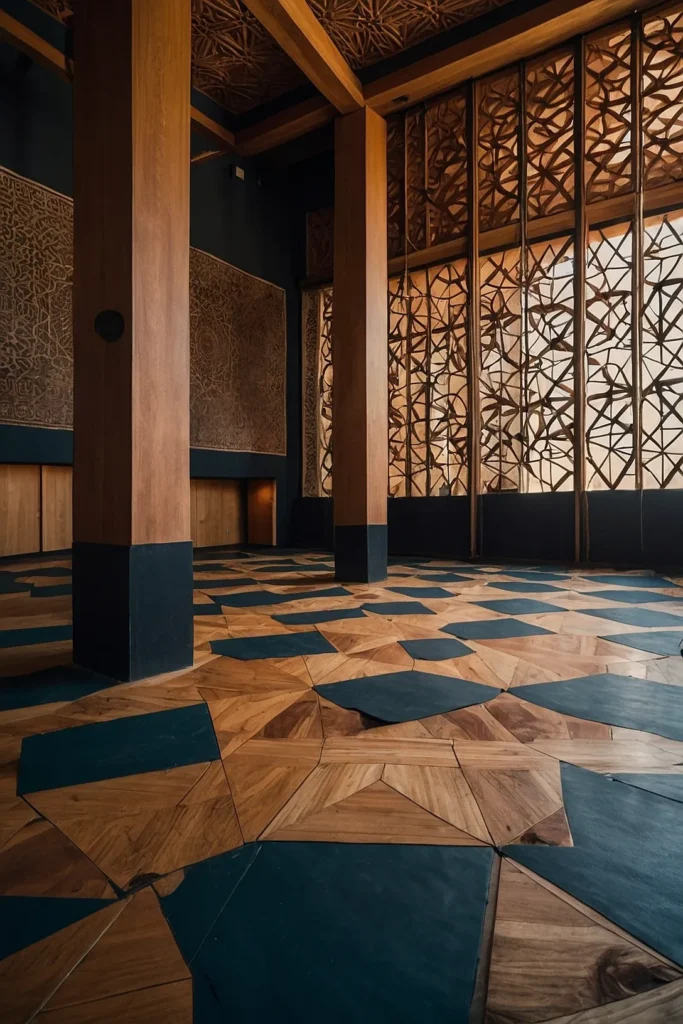
Incorporate subtle sacred geometry patterns in flooring layouts using natural materials that guide placement and movement without obvious markings.
The mathematical patterns support alignment and flow while honoring spiritual traditions through design.
You’ll create invisible guidance systems that enhance practice quality.
Choose proportions that feel natural and support common pose sequences.
The geometry should enhance rather than restrict movement possibilities.
Conclusion
Create your serene Japandi yoga sanctuary using these mindful design elements that honor both Japanese minimalism and Scandinavian functionality for transformative practice spaces.




